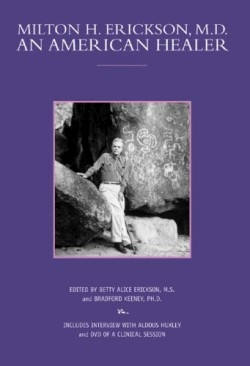
Milton H. Erickson, M.D.
An American Healer
Psychiatrist, guru of modern hypnosis, acute observer of life and the human condition from a wheelchair, Milton Erickson (1901—1980) comes back to life in this book, enriched with pictures and sound. He practiced what he preached, avoiding grand theories of human behavior, just listening and observing, treating every person as unique. He listened so well that many people thought he was speaking when he was just paying attention.
There grew up a mystique about the man, and a following. (He is not to be confused with Erik Erikson, the German-American psychologist famous for Childhood and Society). Some of the many books about Milton Erickson try to divine a “technique” or claim his precious mantle, but Erickson’s hypnotic inductions were anything but standardized, usually informal conversation or musings, gentle and provocative. Social scientist Gregory Bateson called him the Mozart of communication; ironic, since Erickson was tone deaf, color blind, and ravaged by polio.
Erickson’s wife of forty years, Elizabeth Moore Erickson, writes the heartfelt preface to this book. The introduction is by Bradford Keeney, editor of “Profiles of Healing,” eleven volumes on the lives and teachings of healers from diverse backgrounds and cultures (with digital recordings). Keeney sees the development of Erickson’s resources in light of shamans and indigenous healers. “They begin their journey with a personal crisis,” he writes, “often physical in nature, and set forth to find their own means of overcoming it. In the victory of learning how to bring themselves back to life, so to speak, they learn the skills that enable them to help others survive, endure, and thrive.”
Hypnosis has gained much respect since Erickson started a professional society and journal in 1958, no longer dismissed as stagecraft, or medicine for hysterics. His partnership approach replaced the authoritarian one of Freud’s era, helping people along a path of their own choosing. He led, often indirectly, occasionally tripping someone in order to create forward momentum, divert them from an obsession, get them unstuck.
Erickson’s daughter, Betty Alice, a therapist, presents “Dad” as teacher and helper, keen naturalist, scrupulous observer and note-taker who loved his work and the people he engaged when he felt they were ready. She writes: “Dad saw what was needed inside another and was, by his own connection to that deep part of them, able to help them access and bring forth that piece within themselves. That is healing—helping from within.”
Some people—less than ten percent—are so highly hypnotizable that they can undergo surgery without anesthetic—and another ten percent cannot use it at all. Most people are in between these extremes. Erickson’s notion of “trance” was broad, including everyday experience. Many people realize after driving to a destination that they missed something on the radio that they intended to hear (news, weather) because their mind was somewhere else. That’s trance. Reading or hearing a good story is a trance induction. Reading is especially remarkable because people have to practice over many years to transform lines of black marks on white paper into a mental conveyer belt that takes them far away while they create images and emotions for themselves. Psychologists debate whether hypnosis involves altered states of consciousness or merely conforming to suggestions compliantly.
As Betty points out, “all great storytellers, therapists, parents and teachers, children, all practitioners of effective human communication use the principles of hypnosis. Part of that is making a good relational connection, listening, and suggesting.”
In addition to family and collegial reminiscences, the book contains some Erickson letters, his travel adventure diary from age twenty, a hypnosis session transcript (the DVD contains the filmed session), and an article he wrote on a trance induction and discussion with Aldous Huxley. The colleagues and students represented include some well-known Ericksonian authors (Stephen Gilligan, Stephen Lankton, Ernest L. Rossi, Sandra Sylvester) several other therapists, a sculptor and a police detective. Ordinary and extraordinary, psychiatrist and shaman, sensible and quirky, nature lover, storyteller, Erickson saw living as rehabilitation. Having healed himself repeatedly, he knew how to help others heal themselves. He loved people, considered them basically good, and believed they knew more than they knew they knew. Ericksonian wording can both clarify and confuse: he purposely used it to put the ball in the other’s court, to make the person stretch without being hurt.
Rarely does a genius qualify as exemplary teacher, friend, lover, family member. Milton Erickson is such a one. Readers of this book will learn about a human genius, Western shaman, soul doctor (psych-iatrist), a charming, simply wise man. Thanks to his family and friends he will be deservingly appreciated by a greater audience.
Reviewed by
E. James Lieberman
Disclosure: This article is not an endorsement, but a review. The publisher of this book provided free copies of the book to have their book reviewed by a professional reviewer. No fee was paid by the publisher for this review. Foreword Reviews only recommends books that we love. Foreword Magazine, Inc. is disclosing this in accordance with the Federal Trade Commission’s 16 CFR, Part 255.
